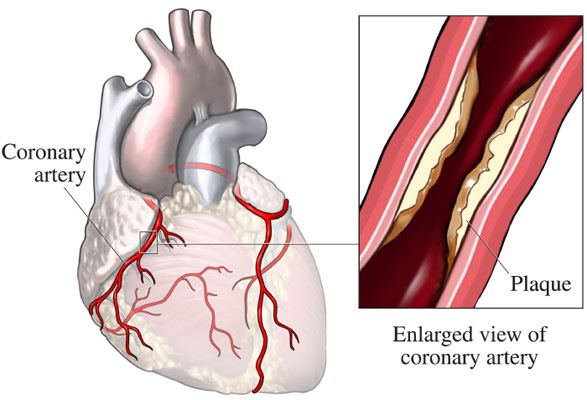Coronary Artery Disease
The coronary arteries are the main blood vessels that supply blood and oxygen to the heart muscle. When these arteries become narrowed, it’s called coronary artery disease (CAD) or coronary artery stenosis. The narrowing is due to the buildup of plaque (atherosclerosis) inside the wall of the coronary artery. As plaque builds up, the walls of these arteries start thickening. This thickening reduces the amount of blood flow to organs and tissues connected to these arteries.
CAD reduces the flow of oxygen to the heart. CAD may occur suddenly (acute) or develop gradually (chronic). Either way, the heart needs a constant supply of oxygen to work. If the narrowing of the coronary arteries becomes severe or if a piece of plaque breaks off, a heart attack can occur. CAD is similar to carotid artery disease, in which buildup occurs in the arteries of the brain.

Medical Illustration Copyright © 2019 Nucleus Medical Media, All rights reserved.
Causes of Coronary Artery Disease
Coronary artery disease is caused by plaque buildup in the walls of the arteries that supply blood to the heart and other parts of the body. However, other conditions, traits or habits may also play a role in raising your risk for this disease. These conditions are known as risk factors and include:
Non-Modifiable Risk Factors: These factors are irreversible and cannot be changed. The more of these risk factors you have, the greater your chance of developing CAD.
- Family history/Genetics
- Anyone 65 years or older
- Being post-menopausal for women
- Male gender
Modifiable Risk Factors: These factors can be modified, treated or controlled through medications or lifestyle changes.
- Diabetes: When your blood glucose, also called blood sugar, is too high.
- High blood pressure
- High cholesterol
- Little to no physical activity.
- Long history of cigarette smoking and/or drug abuse.
- Obesity or having a body mass index “BMI” of 30 or greater.
- Extreme emotional stress.
- Excessive consumption of alcohol over many years.
Symptoms of Coronary Artery Disease
The signs of CAD can vary. Some people have no symptoms at all. This is fairly typical during the early stages of the disease. But as plaque continues to build up in your coronary arteries, you may develop several symptoms, including:
- Chest pain, fullness, discomfort or pressure
- Lightheadedness/Fainting
- Fatigue
- Shortness of breath
- Nausea and/or vomiting
- Sweating
In worse case scenarios, your first symptom may occur in the form of a heart attack.
Diagnosis of Coronary Artery Disease
To diagnose CAD, your doctor will take a careful look at your medical history, review your symptoms and perform a physical examination. After that, you may have one or more of the following diagnostic tests and procedures:
- Electrocardiogram (EKG)
- Stress test
- Echocardiogram (ECHO)
- Cardiac catheterization
- Computed tomography (CT scan)
Treatment of Coronary Artery Disease
Coronary artery disease involves a balance of the right lifestyle changes, medications and, in some cases, medical procedures.
Lifestyle Changes
- Avoid smoking.
- Avoid alcohol consumption.
- Eat a heart-healthy diet.
- Exercise under the directions of your doctor.
- If you’re overweight, discuss with your doctor various weight-loss options.
- Manage stress.
- Make and keep appointments to see your doctor for routine check-ups and follow-up tests.
Medications
- Aspirin will treat pain, inflammation and reduce the risk of heart attack.
- Antiarrhythmic medications will help control your heart rhythm.
- Beta blockers will help reduce your blood pressure.
- Statins will help reduce the level of cholesterol in the blood.
